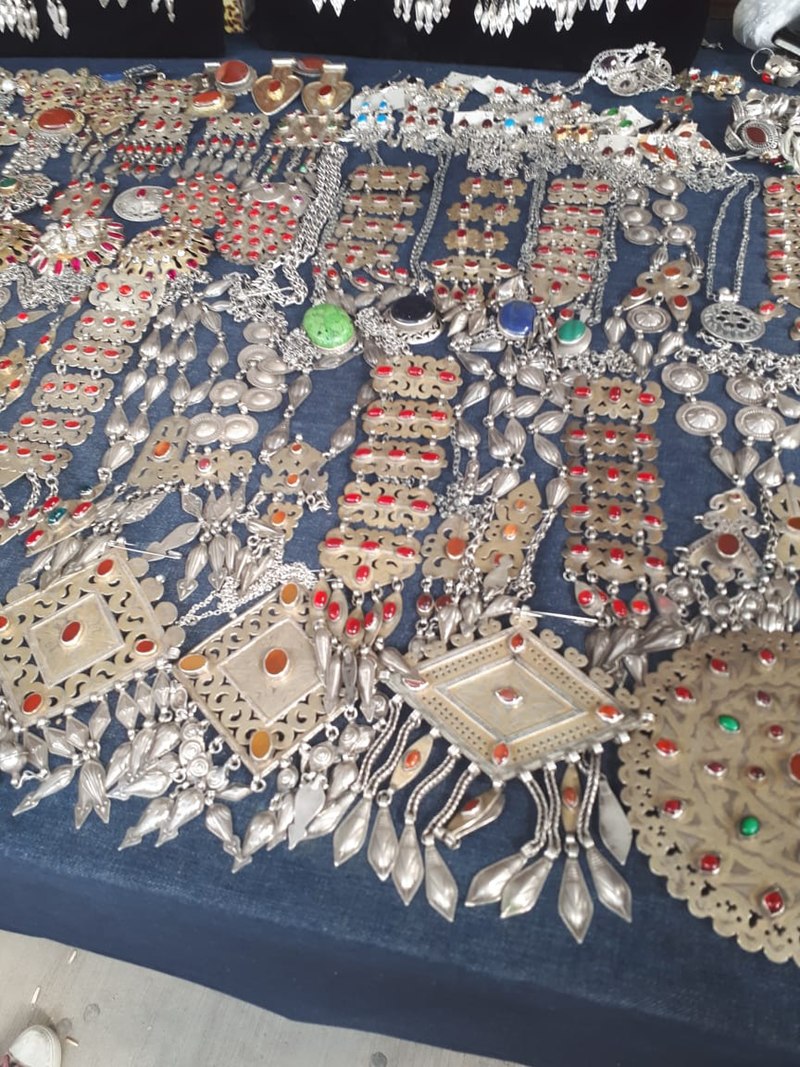 |
| World's largest yurt, just outside of Mary, Turkmenistan |
Many of these nomadic clans live in yurts, which are decorated with Turkmen carpets. These rugs weren’t just used as floor coverings, but they used them as bags, wall coverings, and door hangings as well. Today, many of these rugs are produced to be exported to other nearby countries; Pakistan and Iran are huge fans of these rugs. These rugs are characterized by their natural dyes (although some synthetic dyes may be used in commercially made ones now), and many are a reddish or brown/tan color. They also tend to use geometric repeating patterns. Some of these patterns have a particular meaning behind them, and some were representative of different clans.
Jewelry has a special place in Turkmen society. Not only is it worn because it’s pretty, but it’s also worn for spiritual reasons as well as to show their standing in society. Silver is commonly used, and it’s often decorated with precious and semi-precious stones. The stones themselves have special meanings to them as well; and some of these stones, they believe have magical powers to them (wonder which stone wards of coronavirus?).
Another unique part of Turkmen culture is a type of hat known as the telpek hat. These high, shaggy hats made out of black sheepskin look kind of like afros from a distance. However, I think they can come in different styles and other colors. Worn by men in traditional dress, they’re typically accompanied by a white shirt underneath a red robe. Women, on the other hand, typically wore a long slack dress over a pair of thin pants that were usually embroidered at the ankle -- with of course, jewelry! Today, they wear more Western-style clothes.
As far as Western-style painting arts goes, it didn’t really take off until the 20th century. Some of the names to look for include Durdy Bayramov (active during the Soviet era, he was given the highest honor of People’s Artist of Turkmen SSR, known for his portraits, still lifes, and landscapes), Husein Huseinov (known for his landscape painting, he’s also the artistic director for several films), Izzat Klychev (the name that sounds like a question, also a People’s Artist of Turkmen SSR recipient, known for his painting series “My Turkmenia”), Byashim Nurali (painter, art teacher, was killed in an air crash in 1965), and Amangeldy Hydyr (has a focus on nature and Turkmen history, his works are often included in exhibitions on Turkmen art).
| by Izzat Klychev |
Throughout the country, the Turkmen language is the most widely spoken language used. Many people who live in the capital of Ashgabat also speak Russian, though. Most of their early works were passed down by word of mouth. There were bards known as bakhshi who would recite these pieces of literature or historical tales. Later on, Turkmen literature grew out of influences of Persian literature as well as Uzbek, Turkish, and Azerbaijani traditions. Even under Russian control, Turkmen literature continued to be produced.
 |
| Magtymguly Pyragy |
Two poets stand out as representing Turkmen poetry and literature. Magtymguly Pyragy is not only an 18th-century poet but was also a sufi and spiritual leader. His poetry generally centered around philosophy, and he was dubbed the father of Turkmen literature. Because he often wrote in Turkmen and not in Persian, one of the main languages of poetry in that area, and because he promoted a unified Turkmenistan, he became a central figure in the country’s history. There are tons of streets and buildings named after him.
Also writing in the late 18th century and early 19th century, Mämmetweli Kemine was a satirical poet of the time. There’s not a lot of information about him out there that wasn’t already the same short, uncited abstract copy and pasted verbatim on most sites I pulled up. However, I did manage to find the article in Turkmen that I ran through Google Translate. It turns out that he switched schools to attend a madrassa in Bukhara, which changed his life. He would often sit around and talk about poetry and music, and he had a lot of close ties with many of the contemporary poets of the day. Many of his poems were centered around life, social relations, and what he thought of as universal love.
 |
| Berdi Kerbabayev |
One 20th-century author to note is Berdi Kerbabayev. He’s one of the most prominent authors of that century and is most widely known for his 1940 novel Aygïtlï ädim (The Decisive Step) and his 1957 novel Nebit-Dag. Not only was he a novelist, he also wrote quite a few plays and poems and completed several translations.
Up next: music and dance









